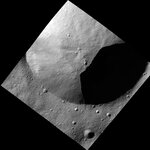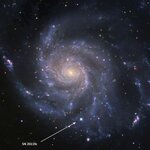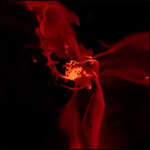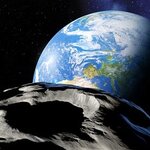Space

NASA is featuring the first high-resolution images of asteroid Vesta as taken by the DAWN spacecraft during a low-altitude orbit. The images show a very interesting surface, battered with old and more recent craters, plus "textures such as small grooves and lineaments that are reminiscent of the structures seen in low-resolution data from the higher-altitude orbits. Also, this fine scale highlights small outcrops of bright and dark material." (from the NASA piece).
An image gallery with many beautiful pictures is available here. Among the images I could not resist grabbing the one shown below…

Galaxies are theorized to have massive black holes at their centers but the one in the Milky Way is the only supermassive black hole close enough for astronomers to study in detail. A recent violent encounter is a unique chance to observe how a black hole gulps gas, dust and stars as it grows ever bigger.
The normally quiet neighborhood around the massive black hole at the center of our Milky Way Galaxy is being invaded by a gas cloud that is destined in just a few years to be ripped, shredded and largely eaten. The Chandra X-ray satellite has already scheduled its largest single…

Type Ia supernovae, the extraordinarily bright "standard candles" astronomers use to measure cosmic growth which led to the theory of dark energy in 1998 and 13 years later to a Nobel Prize "for the discovery of the accelerating expansion of the universe" have remained mysterious – how they detonate and what the star systems that produce them actually look like before they explode - has been unknown.
On August 24 of this year, while searching data as it poured into DOE's National Energy Research Scientific Computing Center (NERSC) from an automated telescope on Mount Palomar in…

Queue the 'life on other planets' media buzz. NASA's Kepler Mission has discovered the first super-Earth orbiting in the habitable zone of a star similar to our Sun.
The host star lies about 600 light-years away from us toward the constellations of Lyra and Cygnus. The star, a G5 star, has a mass and a radius only slightly smaller than that of our Sun, a G2 star. As a result, it is about 25% less luminous than the Sun. The planet orbits the G5 star with an orbital period of 290 days, compared to 365 days for the Earth, at a distance about 15% closer to its star than the Earth from the…

Cosmic particle accelerators may be more efficient than previously thought, according to a discovery which has revealed the initial stages of acceleration for the first time.
In space, large magnetic fields guide cosmic rays across the Universe at almost the speed of light, but they don't start them moving in the first place. And you need some way to begin the acceleration process. The Large Hadron Collider at CERN uses a series of small accelerators to get its particles up to speed before injecting them into the main 27 km-circumference ring for further acceleration.
ESA's…

Is the author of 'open notebook astronomy' an idiot? Over at 365DOA, there is a full article on open notebook astronomy. What is open notebook? Making your data and your work visible, rather than only presenting the subset you find personally relevant.
How does this help science? Well, I could re-imagine the above article, but without openness. Instead, I just present the parts that I think are relevant to my argument that the author of open notebook astronomy is, indeed, an idiot.
To support this, he starts with "Much of [...] an astronomer [is] a secret."…

The last few years have seen a real spike in end-of-the-world conspiracy theories. Why? More asteroids, more flares, more earthquakes? No, just more Internet to talk about them, which gives bored news media something to talk about and bored science sites more news media to debunk.
At least one end-of-the-world scenario for 2012 has been eliminated already - like the Christmas shopping season, people are pushing debunking the apocalypse farther and farther back and science is already eliminating 2012 apocalypses before 2011 is even over. Sheesh. When will we learn…

Scientists have found pristine clouds of the primordial gas that formed just after the Big Bang and it matches the composition made by predictions, which adds to direct evidence in support of the modern cosmological explanation for the origins of elements in the universe. Only the lightest elements, mostly hydrogen and helium, were created in the Big Bang. A few hundred million years passed before clumps of this primordial gas condensed to form the first stars, where heavier elements were forged.
But astronomers have always detected "metals" (their term for all elements heavier than…

It is approaching fast. And it is big. The next NEO (Near-Earth Object) encounter that is. This Tuesday, a 400 m (1,300 ft) diameter rock, known as 2005 YU55, will pass by earth at a distance that is from astronomical perspective truly minuscule: 0.00217 AU. In a solar system that stretches more than 80 AU in diameter, that is less than a hair width. Such close encounters for objects of this size are expected to occur no more than a few times per century.
Earth, keep starboard - we are going to pass!
The last time an event like this happened was 35 years ago. End December 1976 a…

A total solar eclipse - There are waves above you too
It is a scene to watch - the dark shadow move across the land and sea when the moon comes in front of the sun and the earth during a total solar eclipse.
Jianlin Liu of the National Central University in Taiwan and colleagues used Global Positioning System (GPS) technology to confirm a four decade old prediction that this shadow creates a pocket of high pressure air that cuts through the upper atmosphere similar to a boat moving through water.
THE PHENOMENON –IN REAL
To understand this effect, imagine the childhood pastime of…